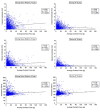The Role Of Contact Force In Atrial Fibrillation Ablation
- PMID: 27957075
- PMCID: PMC5135144
- DOI: 10.4022/jafib.1027
The Role Of Contact Force In Atrial Fibrillation Ablation
Abstract
During radiofrequency (RF) ablation, low electrode-tissue contact force (CF) is associated with ineffective RF lesion formation, whereas excessive CF may increase the risk of steam pop and perforation. Recently, ablation catheters using two technologies have been developed to measure real-time catheter-tissue CF. One catheter uses three optical fibers to measure microdeformation of a deformable body in the catheter tip. The other catheter uses a small spring connecting the ablation tip electrode to the catheter shaft with a magnetic transmitter and sensors to measure microdeflection of the spring. Pre-clinical experimental studies have shown that 1) at constant RF power and application time, RF lesion size significantly increases with increasing CF; 2) the incidence of steam pop and thrombus also increase with increasing CF; 3) modulating RF power based on CF (i.e, high RF power at low CF and lower RF power at high CF) results in a similar and predictable RF lesion size. In clinical studies in patients undergoing pulmonary vein (PV) isolation, CF during mapping in the left atrium and PVs showed a wide range of CF and transient high CF. The most common high CF site was located at the anterior/rightward left atrial roof, directly beneath the ascending aorta. There was a poor relationship between CF and previously used surrogate parameters for CF (unipolar or bipolar atrial potential amplitude and impedance). Patients who underwent PV isolation with an average CF of <10 g experienced higher AF recurrence, whereas patients with ablation using an average CF of > 20g had lower AF recurrence. AF recurred within 12 months in 6 of 8 patients (75%) who had a mean Force-Time Integral (FTI, area under the curve for contact force vs. time) < 500 gs. In contrast, AF recurred in only 4 of 13 patients (21%) with ablation using a mean FTI >1000 gs. In another study, controlling RF power based on CF prevented steam pop and impedance rise without loss of lesion effectiveness. These studies confirm that CF is a major determinant of RF lesion size and future systems combining CF, RF power and application time may provide real-time assessment of lesion formation.
Keywords: Atrial Fibrillation; Catheter Ablation; Contact Force; Electrophysiology; Mapping; Radiofrequency.
Figures









References
-
- Avitall B, Mughal K, Hare J, Helms R, Krum D. The effects of electrode-tissue contact on radiofrequency lesion generation. Pacing Clin Electrophysiol. 1997 Dec;20 (12 Pt 1):2899–910. - PubMed
-
- Haines DE. Determinants of lesion size during radiofrequency catheter ablation: the role of electrode-tissue contact force and duration of energy delivery. J Cardiovasc Electrophysiol. 1991;2:509–515.
-
- Strickberger S A, Vorperian V R, Man K C, Williamson B D, Kalbfleisch S J, Hasse C, Morady F, Langberg J J. Relation between impedance and endocardial contact during radiofrequency catheter ablation. Am. Heart J. 1994 Aug;128 (2):226–9. - PubMed
-
- Zheng X, Walcott G P, Hall J A, Rollins D L, Smith W M, Kay G N, Ideker R E. Electrode impedance: an indicator of electrode-tissue contact and lesion dimensions during linear ablation. J Interv Card Electrophysiol. 2000 Dec;4 (4):645–54. - PubMed
-
- Nath S, DiMarco J P, Gallop R G, McRury I D, Haines D E. Effects of dispersive electrode position and surface area on electrical parameters and temperature during radiofrequency catheter ablation. Am. J. Cardiol. 1996 Apr 1;77 (9):765–7. - PubMed
Publication types
LinkOut - more resources
Full Text Sources
Research Materials
